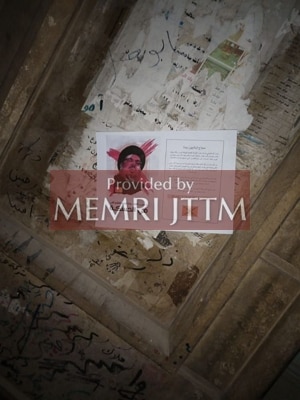The following report is now a complimentary offering from MEMRI's Jihad and Terrorism Threat Monitor (JTTM). For JTTM subscription information, click here.
In recent years the Syrian regime, headed by Bashar Al-Assad, has been conducting a struggle against the American military presence in Syria by means of what it refers to as "popular resistance." This resistance is expressed by blocking roads and throwing stones when convoys of the Global Coalition to Defeat ISIS or American forces move around the country. Over the past year there has been an escalation in the "popular resistance" which has included rocket fire at bases where these forces are stationed, and the detonation of IEDS on their convoys. This activity, which is described as a popular initiative, is in fact organized and directed by the Syrian regime.[1]
One of the main points of friction between the forces loyal to the Syrian regime and the American forces is the area in the Al-Hasakah Governorate and the city of Qamishli, part of which is controlled by the Syrian Democratic Forces (SDF) and the American forces.
According to reports on Syrian opposition websites and in the Arab media, Iran is seeking a foothold in the area. Similar to the way it has operated in other parts of Syria, in this region as well it is attempting this by means of moving militias which are loyal to it to the area, first and foremost Hizbullah, and also by establishing a local base of tribal supporters by recruiting tribal leaders who are loyal to the regime and setting up local and tribal militias which operate in accordance with its instructions.
These reports also assert that in 2021 Iran sought the support of the regime's National Defense militia by offering financial enticements, and also the support of the tribesmen to exhibit "resistance" against the American forces in the area. On February 14, 2021, the Syrian Observatory for Human Rights (SOHR) reported that the Iran-backed Afghan-Shi'ite Fatemiyoun Brigade had recruited about 250 men from Qamishli and Al-Hasakah by using monetary incentives.[2]
About a year later, the website reported that according to data it possesses, Iran had recruited 800 residents from the same areas, 390 of whom were members of the National Defense militia and 410 from among the local tribes.[3]

With Russia Busy in Ukraine, Iran is Intensifying Efforts to Recruit Tribesmen in Al-Hasakah
Despite the seemingly large number of residents recruited, the amount seems to have fallen short of Iran's goal, and recent reports in Arab media state that Iran is increasing its efforts to garner support from among the tribes, among other reasons in order to orchestrate "popular resistance" against the American forces. These sources believe that Iran's timing is related to the fact that Russia is currently occupied with its war on Ukraine.
On April 22, 2022, the SOHR website reported on a meeting held by an "Iranian commander" with about 100 tribesmen and operatives from the regime-backed militias in the city of Qamishli during which the possibility was discussed that a military council would be created which would operate according to instructions from Iran against "the American and SDF plan," and also discussed was an initiative to recruit tribal members to fight against the Islamic State. The report states that every recruit would receive about 200,000 Syrian pounds (about $80), supplies of food, and a security certificate which would protect its bearer from mandatory conscription by the regime forces.[4]
Less than a week later, the Al-Arabi Al-Jadid daily, published in London, reported that a Hizbullah operative known as Hajj Mahdi was overseeing the Iranian presence in the area and that he had nurtured good relationships with the tribal dignitaries.[5] About two months after that report appeared, the Al-Quds Al-Arabi daily, also published in London, reported that Iran was training members of the National Defense militia and the Syrian regime's Ba'ath Brigades from Al-Hasakah at an Islamic Revolutionary Guard Corps (IRGC) base in the Al-Dimass area, west of Damascus. Furthermore, Hizbullah reportedly opened a recruitment center for local youth, promising that it would solve their problems with the regime, especially the problems of those who were attempting to evade mandatory military service, or those who had perpetrated minor crimes.
Al-Quds Al-Arabi alleges that over the past six months the center recruited about 100 youths from among the local tribes. Its article states that they dress in civilian clothes and are tasked with blocking the joint patrols conducted by the American and SDF forces by placing burning tires in their path and throwing stones at them. The report adds that the families of these recruits, including women and children, also participate in these activities.
The report further states that the recruitment center provides financial support to independent tribal groups, one of which is led by Faez Al-Namis and numbers 25 members. It also writes that the Iranians have won the support of operatives in groups in the area that are backed by Russia, such as the members of the volunteer brigades at the Qamishli airport, and adds that Hajj Mahdi has built a strong relationship with air force intelligence and the state security branch in Al-Hasakah Governorate.[6]
Syrian Journalist: Iran Seeks to Recruit Cells to Attack American Patrols
Syrian journalist Samir Al-Ahmad told the Arabi21website that the objective of Hajj Mahdi is to incite local residents against the American presence, and to recruit cells whose mission will be to provoke the members of the American patrols and obstruct their movement as part what is referred to as "popular resistance." According to Al-Ahmad, on the strategic level Iran seeks to take control of the oil and gas fields in eastern Syria and also of the Al-Ya'rubiyah border crossing between Syria and Iraq. Control of this border crossing will provide Iran with free access between the areas it controls in northern and central Iraq and those it controls in Qamishli. This crossing is also intended as an alternative to the Al-Qa'im border crossing, in the event that it is bombed by Israel or the American forces.[7]
Opposition of Al-Hasakah Residents to Hizbullah Presence
The Iranian and Hizbullah attempts at recruitment were not well-received by the entire population. In late June 2022 notices were put up and pamphlets were distributed in the streets of the city of Al-Hasakah condemning the presence of Hizbullah and Iran in the area. One notice titled, "Lebanese Pilgrims among Us," states that in every place where Hizbullah is found there is instability and despicable crimes are perpetrated. It also claims that Hizbullah finances its activity with drug-dealing. The announcement asserts that, "Unfortunately for the residents of Al-Hasakah this group is among us now while it camouflages its presence on the bases of the regime and operates secretly to destroy the security and stability. Every month Hizbullah imports more and more weapons to Al-Hasakah. The Lebanese pilgrims stay in 'the security zone' and supervise the activity from there. Headed by Hajj Mahdi they attempt to recruit our young people and to transform them into agents for external elements [operating] against their own people." The text on the notice concludes, "We, the residents of Al-Hasakah will not accept this. We do not want a Hizbullah presence in our city." The announcement also displays a photograph of Hizbullah Secretary General Hassan Nasrallah with a giant red X across his face and text below it which reads, "No to Hizbullah, No to the Victory of the Devil [this is wordplay on Nasrallah's name, which means "Victory of God"] in Al-Hasakah."[8]



[1]For more information about this strategy see for example, MEMRI JTTM Report: Amid Escalating Attacks On U.S. Bases In Syria, Syrian Press Calls To Expand Popular Resistance Until Americans Withdraw, January 1, 2022.
[2] Syriahr.com, February 14, 2021.
[3] Syriahr.com, April 22, 2022.
[4] Syriahr.com, April 22, 2022.
[5] Alaraby.co.uk, April 28, 2022.
[6] Al-Quds Al-Arabi (London), June 18, 2022.
[7] Arabi21.com, June 20, 2022.
[8] Facebook, June 28, 2022; and Telegram, June 28, 2022.
The full text of this post is available to subscribers.
Please login or register to request subscription information from MEMRI




